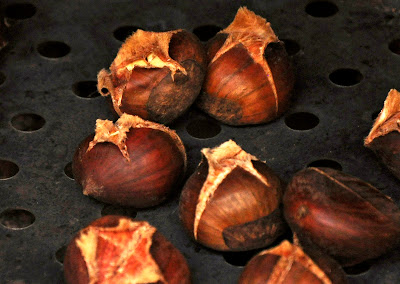Chestnuts roasting on an open fire, Jack Frost nipping at your nose...
Toasted chestnuts evoke wistful holidays images of days gone by. But how many of us have actually roasted chestnuts on an open fire? Too few, I imagine. And a shame, too, since anyone with a fireplace can do it easily. All you need are chestnuts, a good knife and a roasting pan.
Just take as many chestnuts you and your dining companions want to eat and cut a cross in their sides as picture. This will prevent them from 'exploding' while they roast. You can do with this a good, sharp knife. They also make chestnut knives as well as a special instrument for the job (pictured below), which you can find at specialty stores or online; it makes the job a lot easier.
The typical pan for roasting chestnuts is made of carbon steel and has large holes in its bottom to let the heat of the fire through. They are sometimes available in specialty cookware shops and online. You can also use a popcorn popper, the kind they make for fireplaces, with long handles.
Now take the pan and lay it over some hot embers. If your fireplace is big enough you can just clear out a space and pull some embers into place below your pan. You pan should lay a few centimeters/inches above the embers, which should be glowing red hot, but not actually on fire. An actual flame would char the outsides of the chestnuts before they are done inside.
Tossing them from time to time, let the chestnuts roast for about 20 minutes or so. As they roast, the slits you have made in their sides will begin to open. This is fine. The chestnuts will char a bit on the outside, which is perfectly normal and, in fact, desirable, as it gives them a nice smokey flavor. Some recipes tell you to sprinkle some red wine or other liquor over them as they roast, which you can certainly do if that appeals to you.
Once they're done, remove them gingerly from the pan into a cloth towel. (They will be very hot at this point, as will your pan, so be careful.) Wrap the chestnuts up for a few minutes to let them cool off a bit and soften further. Then open up the towel and eat them, preferably with your hands. They have both shells and a rather woody skin. You can eat the latter if you like, but they are much nicer without. The skins should, in any event, come off quite easily if they chestnuts are still warm.
NOTES: If you don't have a fireplace or an appropriate pan, the same basic technique can be used to roast chestnuts on a baking sheet, in a hot oven.
Chestnuts make for a wonderful 'dessert', made after dinner, say while watching a film and sipping some whiskey or grappa on a cold winter's night. Or while singing yuletide carols, perhaps...
